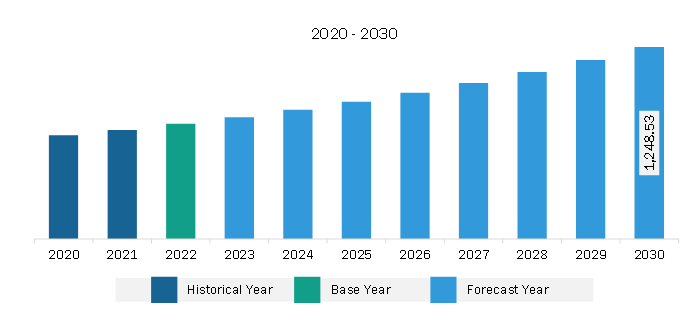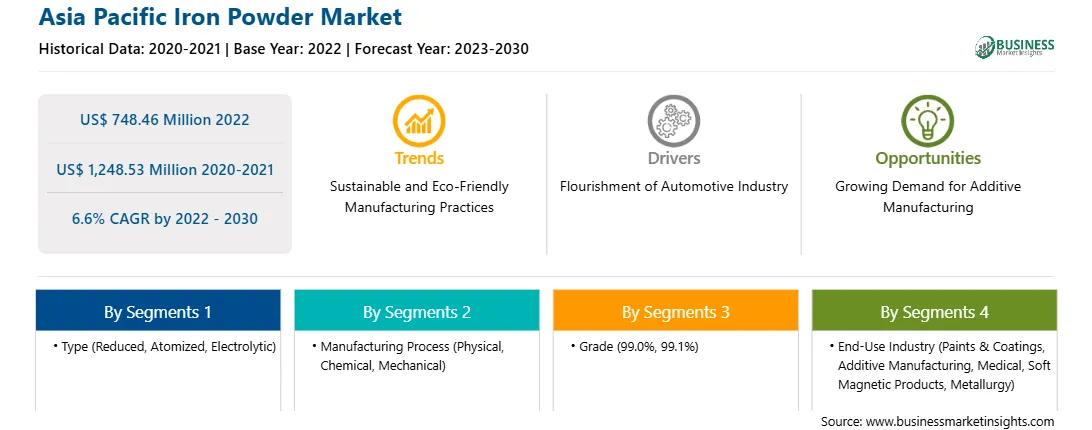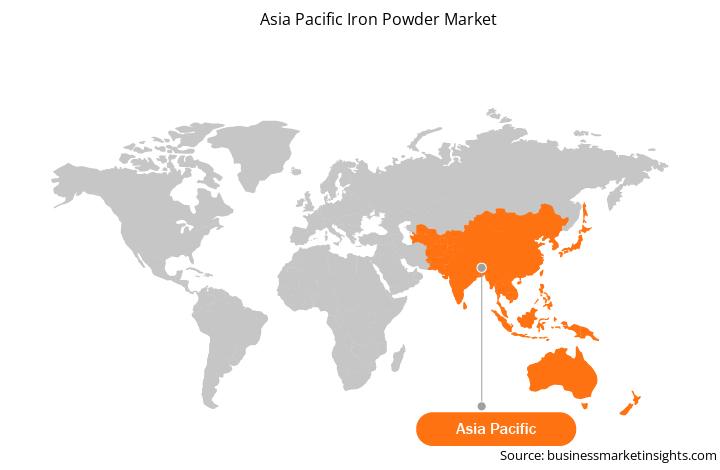The Asia Pacific iron powder market was valued at US$ 748.46 million in 2022 and is expected to reach US$ 1,248.53 million by 2030; it is estimated to register a CAGR of 6.6% from 2022 to 2030.
The automotive industry heavily relies on iron powder as it is a fundamental raw material in the field of powder metallurgy. This manufacturing process involves shaping and sintering metal powders to create intricate parts. Automotive manufacturers increasingly turn to powder metallurgy for the production of components such as gears, bearings, and bushings, as it offers cost-effective, precise, and resource-efficient manufacturing solutions. In addition, in recent years, the automotive sector has heavily invested in reducing the weight of vehicles to enhance fuel efficiency and reduce emissions. Iron powder, when integrated into metal matrix composites and other advanced materials, can contribute to the development of lightweight components that maintain structural integrity. These components are integral to achieving the industry's lightweight objectives, resulting in more fuel-efficient vehicles and a reduced carbon footprint. Hyundai Motor Company inaugurated Hyundai Motor Manufacturing Indonesia, its first factory in Southeast Asia, located in the Deltamas industrial complex near Cikarang, Indonesia, with an initial production capacity of 150,000 units in March 2022. Hyundai plans to invest around US$ 1.55 billion in the plant, and the production capacity will be increased to 250,000 units. In addition, in July 2021, Maruti Suzuki India Ltd. announced an investment worth US$ 2.42 billion in a new manufacturing facility in Haryana, India. The facility is expected to manufacture one million units annually. This growing production and demand for vehicles is driving the demand for iron powder. As the automotive industry experiences a transformative shift toward electric vehicles (EVs), iron powder's role becomes even more crucial. Electric motors used in EVs often rely on iron powder for the production of soft magnetic cores, which are essential for the motors' efficiency and performance. According to the International Energy Agency's annual Global Electric Vehicle Outlook, over 10 million electric cars were sold worldwide in 2022, and sales are projected to grow by another 35% in 2023 to reach 14 million. As the automotive parts sector continues to evolve and innovate, iron powder is poised to remain a fundamental material for the production of high-quality, efficient, and environmentally responsible automotive components.
The Asia Pacific iron powder market is segmented into Australia, China, India, Japan, South Korea, and the Rest of Asia Pacific. These countries are witnessing an upsurge due to growth in urbanization, increasing manufacturing industries coupled with growing industrialization, which offers ample opportunities for key market players in the Asia Pacific iron powder market. The region encompasses an ample number of opportunities for the growth of iron powder. Rising foreign direct investments also lead to economic growth in the region. The growing use of iron powders in numerous applications, including metallurgy, coating and decorations, electronic materials, sintered parts, diamond cutting tools, and others, is anticipated to increase the iron powder demand in Asia Pacific. The increasing projects in the field of electrification, coupled with the growth of the electronics industry in the Asia Pacific, provide lucrative opportunities for the growth of the Asia Pacific iron powder market. According to The Association of Southeast Asian Nations (ASEAN), the electronics industry accounts for 20-50% of the total value of exports of most countries in Asia Pacific. Moreover, the rising automotive sales in the Asia Pacific countries, including India and China, have been one of the most encouraging growth factors for the Asia Pacific iron powder market in recent years. Besides, the growing middle-class population, developing surface transportation infrastructure, rising disposable income, increasing mobility due to the development of satellite townships near megacities, and increasing aspiration of owning private vehicles fuel the market for iron powder in Asia Pacific. Further, the increasing population, along with the soaring economy in the Asia Pacific, has led to industrialization, which will propel product demand, thereby expanding the Asia Pacific iron powder market in Asia Pacific during the forecast period.

Strategic insights for the Asia Pacific Iron Powder provides data-driven analysis of the industry landscape, including current trends, key players, and regional nuances. These insights offer actionable recommendations, enabling readers to differentiate themselves from competitors by identifying untapped segments or developing unique value propositions. Leveraging data analytics, these insights help industry players anticipate the market shifts, whether investors, manufacturers, or other stakeholders. A future-oriented perspective is essential, helping stakeholders anticipate market shifts and position themselves for long-term success in this dynamic region. Ultimately, effective strategic insights empower readers to make informed decisions that drive profitability and achieve their business objectives within the market.

| Report Attribute | Details |
|---|---|
| Market size in 2022 | US$ 748.46 Million |
| Market Size by 2030 | US$ 1,248.53 Million |
| CAGR (2022 - 2030) | 6.6% |
| Historical Data | 2020-2021 |
| Forecast period | 2023-2030 |
| Segments Covered |
By Type
|
| Regions and Countries Covered | Asia-Pacific
|
| Market leaders and key company profiles |
|
The geographic scope of the Asia Pacific Iron Powder refers to the specific areas in which a business operates and competes. Understanding local distinctions, such as diverse consumer preferences (e.g., demand for specific plug types or battery backup durations), varying economic conditions, and regulatory environments, is crucial for tailoring strategies to specific markets. Businesses can expand their reach by identifying underserved areas or adapting their offerings to meet local demands. A clear market focus allows for more effective resource allocation, targeted marketing campaigns, and better positioning against local competitors, ultimately driving growth in those targeted areas.

The Asia Pacific iron powder market is categorized into type, grade, manufacturing process, end-use industry, and country.
Based on type, the Asia Pacific iron powder market is segmented into reduced, atomized, and electrolytic. The atomized segment held the largest market share in 2022.
In terms of grade, the Asia Pacific iron powder market is bifurcated into ≤ 99.0% and ≥ 99.1%. The ≤ 99.0% segment held a larger market share in 2022.
By manufacturing process, the Asia Pacific iron powder market is categorized into physical, chemical, and mechanical. The physical segment held the largest market share in 2022. Furthermore, the physical segment is further subsegmented into atomization and electro deposition. Additionally, the chemical segment is further subsegmented into reduction and decomposition.
Based on end-use industry, the Asia Pacific iron powder market is segmented into paints and coatings, additive manufacturing, medical, soft magnetic products, metallurgy, and others. The metallurgy segment held the largest market share in 2022. Furthermore, the metallurgy segment is further subsegmented into compound brazing, compound sintering, compound welding, and others.
By country, the Asia Pacific iron powder market is segmented into Australia, China, India, Japan, South Korea, and the Rest of Asia Pacific. China dominated the Asia Pacific iron powder market share in 2022.
Rio Tinto Metal Powders, American Elements Inc, Industrial Metal Powders (India) Pvt Ltd, CNPC Powder North America Inc, Ashland Inc, BASF SE, Hoganas AB, JFE Steel Corp, Reade International Corp, and Kobe Steel Ltd are among the leading companies operating in the Asia Pacific iron powder market.
1. American Elements Inc
2. Ashland Inc
3. BASF SE
4. CNPC Powder North America Inc
5. Hoganas AB
6. Industrial Metal Powders (India) Pvt Ltd
7. JFE Steel Corp
8. Kobe Steel Ltd
9. Reade International Corp
10. Rio Tinto Metal Powders
The Asia Pacific Iron Powder Market is valued at US$ 748.46 Million in 2022, it is projected to reach US$ 1,248.53 Million by 2030.
As per our report Asia Pacific Iron Powder Market, the market size is valued at US$ 748.46 Million in 2022, projecting it to reach US$ 1,248.53 Million by 2030. This translates to a CAGR of approximately 6.6% during the forecast period.
The Asia Pacific Iron Powder Market report typically cover these key segments-
The historic period, base year, and forecast period can vary slightly depending on the specific market research report. However, for the Asia Pacific Iron Powder Market report:
The Asia Pacific Iron Powder Market is populated by several key players, each contributing to its growth and innovation. Some of the major players include:
The Asia Pacific Iron Powder Market report is valuable for diverse stakeholders, including:
Essentially, anyone involved in or considering involvement in the Asia Pacific Iron Powder Market value chain can benefit from the information contained in a comprehensive market report.